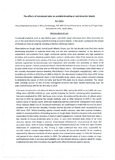
Antarctic Legacy Archive
The effects of introduced mice on seabirds breeding at sub-Antarctic Islands
- ALSA Home
- →
- Documents
- →
- Research: Events, Presentations, Posters
- →
- View Item
JavaScript is disabled for your browser. Some features of this site may not work without it.
The effects of introduced mice on seabirds breeding at sub-Antarctic Islands
Dilley, B.J
Date:
2016/07/27
Abstract:
Introduced predators such as rats (Rattus spp.), cats (Felis catus) and house mice (Mus musculus) are one of the main threats facing seabirds breeding at oceanic islands. In this study I summarise the impact of introduced mice on seabirds breeding at Marion and Gough Islands. Observations on Gough Island, central South Atlantic Ocean, over the last decade show that mice can be devastating predators of seabirds when they are the only introduced mammal. In the absence of competition and predation from larger introduced species, mice have attained very high population densities, and resort to attacking seabird chicks mainly in winter when other food resources are scarce. In 2014 we monitored seven species of burrow-nesting petrels using a combination of infra-red video cameras augmented by burrow scope nest inspections and recorded mice predating on chicks of all seven study species. Camera-monitored Atlantic Petrel (Pterodroma incerta) chicks (n = 7) were all killed by mice within hours of hatching with an 87% chick failure rate (n = 83 hatchlings); mice killed chicks of the recently discovered summer-breeding MacGillivray's Prion (Pachyptila macgillivrayi), with a chick mortality rate of 82% in 2013/14 and 100% in 2014/15. We also closely monitored the fates of 20 Tristan Albatross (Diomedea dabbenena) chicks in the Gonydale study colony using motion-activated cameras to determine the causes of chick mortality and found 93% were due to mouse predation. The island-wide breeding success for this critically endangered albatross has been steadily decreasing over the years and fell below 10% for the first time in 2014. Cats were introduced to sub-Antarctic Marion Island in 1949, and by the 1970s some 2,000 cats were killing about 450,000 seabirds per year, greatly reducing the island's burrowing petrel populations. Cats were eradicated by 1991, but house mice remain. We estimated the densities of utilised petrel burrows in 2013 by repeating the sample methods used by Mike Schramm in 1979 in the north-eastern sector of Marion Island. With cats eradicated and the potential for immigration from nearby Prince Edward Island (free of introduced mammals), we could expect a multi-fold increase in petrel numbers over the last two decades, however burrow densities at Marion have increased by only 56% since 1979. Winter-breeding species showed smaller recovery rates than summer breeders, similar to seasonal patterns of breeding success at Gough Island. Predation by mice is the most likely explanation for the limited recovery of Marion's petrel populations, however there have only been a few records of mouse predations prior to 2015. In 2015 mice attacked large chicks of all three albatross species that fledge in autumn: Grey-headed (Thalassarche chrysostoma) (at least 102 wounded chicks; 4.6% of island fledglings), Sooty (Phoebetria fusca) (45; 4.3%) and Light-mantled Albatrosses (P. palpebrata) (1; 4%). Filming at night confirmed that mice were responsible for wounds. Attacks started independently in small pockets all around the island's 70 km coastline, separated by distances hundreds of times greater than mouse home ranges. In 2016 the frequency and spread of mice attacks was similar to 2015. The widespread nature of mouse attacks on large, well feathered chicks is alarming and highlights not only Marion Island as a priority island for mouse eradication but also that mice alone may significantly affect threatened seabird species.
Files in this item
This item appears in the following Collection(s)
-
Research: Events, Presentations, Posters [490]
Material directly related to official scientific and research events
Search ALSA
Browse
-
All of ALSA
-
This Collection
